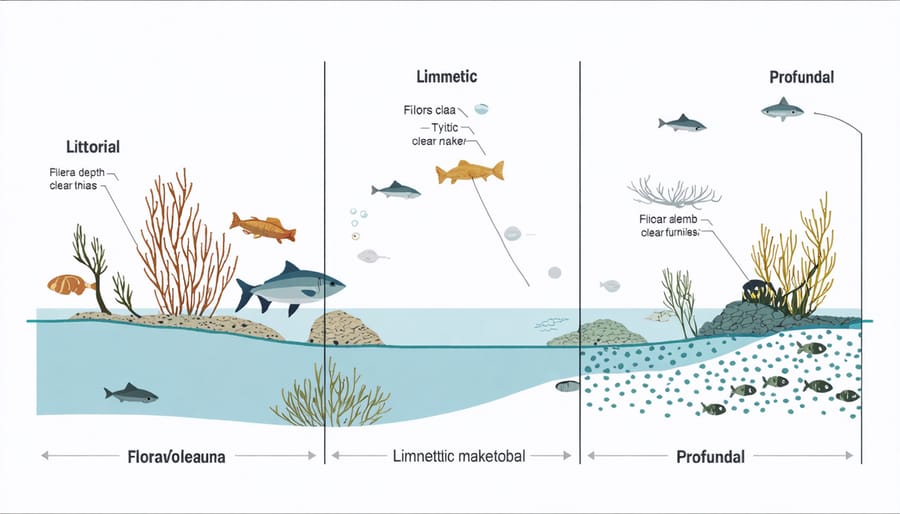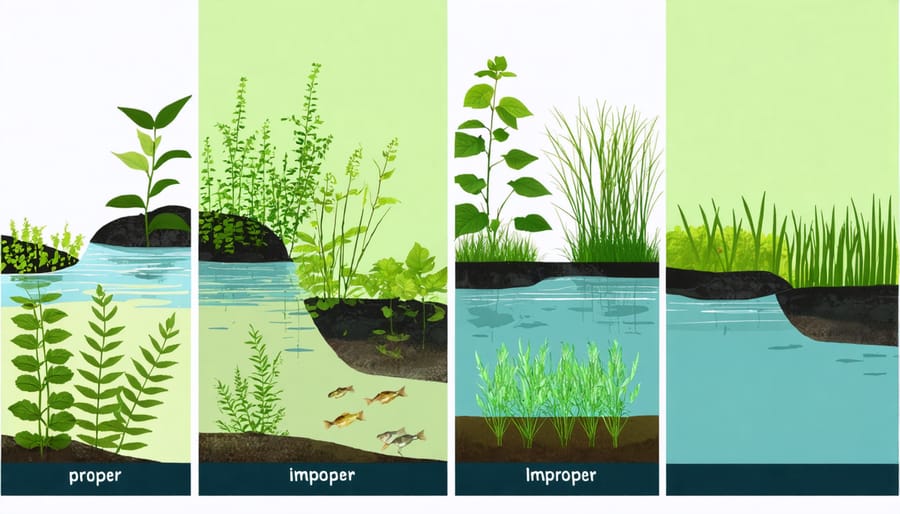
Essential Aquatic Life Zones: How to Create Perfect Living Spaces in Your Pond
Dive into the fascinating layers of your pond ecosystem by understanding aquatic life zones – the distinct regions that shape water quality and fish health. These natural divisions, including the sunlit surface zone, the oxygen-rich middle zone, and the nutrient-dense bottom zone, work together like a perfectly orchestrated underwater neighborhood. Each zone plays a crucial role in maintaining healthy fish populations, supporting beneficial bacteria, and preventing common pond diseases. Whether you’re a seasoned pond keeper or just starting your water gardening journey, knowing these zones helps you create the perfect balance for thriving aquatic life. From proper plant placement to optimal fish feeding locations, mastering these zones transforms your pond from a simple water feature into a vibrant, self-sustaining habitat.
Understanding the Three Main Aquatic Life Zones

The Littoral Zone: Your Pond’s Living Edge
The littoral zone is your pond’s bustling shoreline neighborhood, where land meets water in a vibrant display of life. This shallow area, typically extending from the water’s edge to where sunlight can still reach the bottom, serves as nature’s nursery and feeding ground for countless aquatic species.
Think of the littoral zone as your pond’s living edge, where emergent plants like cattails and rushes create a natural transition between water and land. These plants don’t just add visual interest; they’re essential workers in your pond’s ecosystem. Their roots help stabilize the shoreline, prevent erosion, and filter pollutants before they enter deeper waters.
This zone is particularly crucial for pond health because it provides shelter for young fish, supports beneficial insects, and helps maintain water quality. The abundant plant life produces oxygen during the day and offers hiding spots for smaller pond inhabitants to escape predators. During spring and summer, you’ll notice frogs, dragonflies, and other wildlife gathering here to feed, breed, and rest.
For pond owners, maintaining a healthy littoral zone means finding the right balance of plants and keeping the area clear of excess debris. A well-managed littoral zone acts as your pond’s first line of defense against common problems like algae blooms and poor water quality, while creating a beautiful, natural-looking transition from your garden to the water.

The Limnetic Zone: Open Water Territory
The limnetic zone, often called the open water territory, is where most of the action happens in your pond. Think of it as the “middle layer” – it’s the sun-lit, open water area that extends from the surface down to where sunlight can still penetrate. This zone is bustling with life and plays a crucial role in maintaining your pond’s health.
In this zone, you’ll find free-swimming fish darting about, along with smaller organisms like plankton that provide essential food for your aquatic pets. The water here is typically clearer than in other zones, making it perfect for fish viewing and recreational activities. During different times of the day, you might notice your fish moving up and down within this zone as they follow temperature changes and food sources.
One of the most fascinating aspects of the limnetic zone is its role in oxygen production. This is where photosynthetic organisms like algae and floating plants work their magic, producing oxygen that’s vital for fish survival. The movement of water in this zone also helps distribute nutrients and maintain consistent water temperatures throughout your pond.
For pond owners, understanding the limnetic zone is key to maintaining healthy fish populations. It’s where most feeding activities occur, and its conditions directly impact fish behavior and health. Regular monitoring of this zone’s water quality, including temperature and oxygen levels, will help ensure your aquatic friends thrive in their open-water home.
The Profundal Zone: The Deep Water Layer
The profundal zone, often called the deep-water layer, is the mysterious bottom region of deeper ponds and lakes where light barely penetrates. Think of it as the basement of your water garden, typically found in ponds deeper than 6 feet. This zone is characterized by cooler temperatures, lower oxygen levels, and reduced plant life compared to upper layers.
While this dark zone might seem less exciting than the surface areas, it plays a crucial role in your pond’s ecosystem. During hot summer months, many fish retreat to these cooler depths for comfort and safety. The profundal zone also serves as a vital winter refuge, providing a stable environment when surface waters freeze.
The creatures that call this zone home are specially adapted to low-light conditions. You’ll find bottom-dwelling fish and invertebrates that use touch and chemical signals rather than sight to navigate. The sediment at the bottom is rich in nutrients, supporting beneficial bacteria that help break down organic matter.
For pond owners, understanding the profundal zone is essential for maintaining healthy fish populations. This zone can become problematic if organic matter builds up excessively, potentially leading to oxygen depletion. Regular monitoring of bottom conditions and occasional gentle cleaning can help maintain this zone’s beneficial properties while preventing issues that could affect your pond’s overall health.
Remember, not all backyard ponds need a profundal zone, but in larger systems, it’s an important component of a balanced aquatic ecosystem.
Creating Balanced Zones for Disease Prevention
Proper Plant Distribution
When distributing aquatic plants in your pond, follow the natural layering system. Place marginal plants like rushes and irises along the edges in shallow water, typically 2-6 inches deep. Float water lilies and lotus in the middle zones where water depth ranges from 12-24 inches. Reserve the deepest areas for oxygenating plants like hornwort and anacharis, which thrive in 24-36 inches of water. Remember to group similar plants together and leave enough space between them for growth. For the best results, start with a few plants in each zone and gradually add more as needed, ensuring they have room to establish strong root systems.

Fish Population Management
Maintaining appropriate fish populations in each aquatic zone is crucial for a healthy pond ecosystem. For surface zones, limit fish numbers to prevent overcrowding and oxygen depletion. In the middle zone, ensure there’s enough space for fish to swim freely and find shelter among plants. The bottom zone should support only species that naturally inhabit this area, like bottom feeders.
A good rule of thumb is one inch of fish per ten gallons of water. Monitor fish behavior regularly – if they’re gasping at the surface or seeming stressed, you might need to reduce the population. Remember that different fish species prefer different zones, so mix your fish community accordingly. For example, keep surface-dwelling fish like guppies in the upper zone, while letting catfish patrol the bottom.
Don’t forget that seasonal changes affect how fish use these zones, so adjust your management approach throughout the year.
Understanding and managing aquatic life zones in your pond isn’t just about creating an attractive water feature – it’s essential for maintaining healthy fish and preventing diseases. Each zone, from the surface to the bottom, plays a crucial role in your pond’s ecosystem. By maintaining proper water circulation, oxygen levels, and plant life across these zones, you create an environment where harmful bacteria and parasites struggle to thrive. Regular monitoring of these zones, especially during seasonal changes, helps you spot potential problems before they affect your fish. Remember, a well-balanced pond with clearly defined zones acts as your first line of defense against common fish diseases. Taking care of your pond’s zones today means fewer health issues to deal with tomorrow, and more time to enjoy your thriving aquatic paradise.
